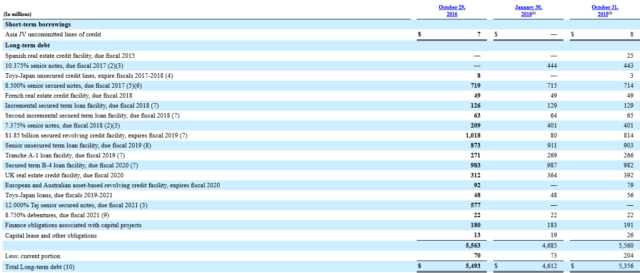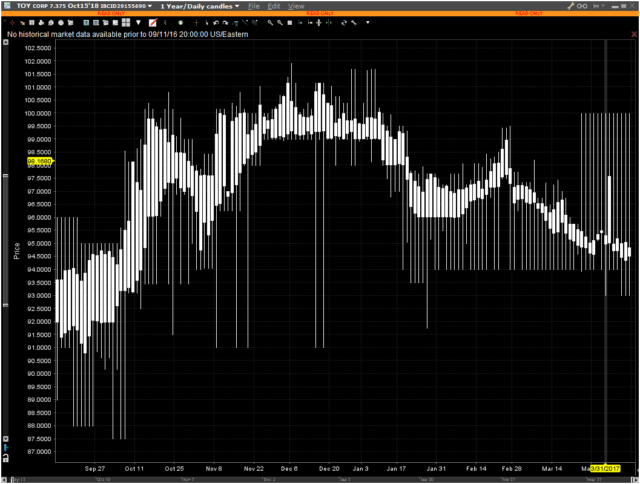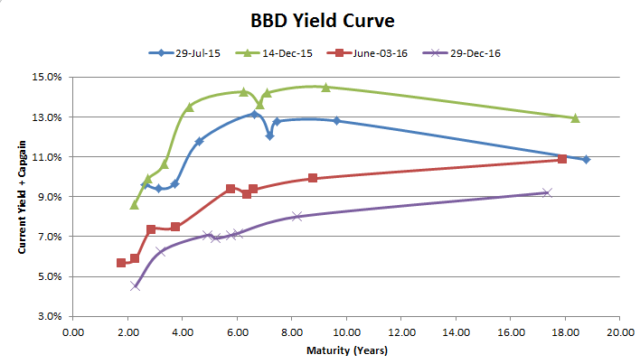I find the Financial Post’s compilation of Canadian exchange-traded debentures to be a very handy list to refer to. It is not comprehensive (there are a few issuers here and there missing) but for the most part is a full snapshot of the market environment.
Looking at the list, I think it is a very good time for Canadian companies of questionable credit quality to be issuing debt. Most of the debt on this list is trading at yields that do not properly represent (my own evaluation of) their risk.
Accordingly my research time is increasingly on the equity side of things in the non-indexed space. A great example of my readings included the Kinder Morgan Canada prospectus, worthy of a future post!
With regards to the debentures, I’ve sorted the debt by yield to maturity and decided to arbitrarily cut things off at 8%:
| Issuer | Symbol | Coupon | Maturity | YTM | Pithy Notes |
|---|---|---|---|---|---|
| Discovery Air | DA.DB.A | 8.38% | 30-Jun-18 | 118.28% | Way behind secured debt, no control |
| Lanesbourough REIT | LRT.DB.G | 5.00% | 30-Jun-22 | 59.10% | Insolvent |
| Gran Columbia Gold Corp | GCM.DB.U | 1.00% | 11-Aug-18 | 43.99% | 81% mandatory equity conversion |
| Primero Mining | P.DB.V | 5.75% | 28-Feb-20 | 21.85% | Operational mess, solvency issues |
| Argex Mining Inc. | RGX.DB | 8.00% | 30-Sep-19 | 19.07% | Illiquid, no revenues! |
| Toscana Energy | TEI.DB | 6.75% | 30-Jun-18 | 17.27% | Senior Debt to cash flow is high |
| Gran Columbia Gold Corp | GCM.DB.V | 6.00% | 02-Jan-20 | 15.14% | I own this |
| Westernone Equity | WEQ.DB | 6.25% | 30-Jun-20 | 13.94% | Likely equity conversion June 30, 2018 |
| Entrec Corp. | ENT.DB | 8.50% | 30-Jun-21 | 13.02% | Cash flow negative, senior debt high |
| Temple Hotels | TPH.DB.D | 7.75% | 30-Jun-17 | 11.78% | One month to maturity |
| Difference Capital | DCF.DB | 8.00% | 31-Jul-18 | 9.56% | Payback not certain |
| Temple Hotels | TPH.DB.E | 7.25% | 30-Sep-17 | 9.47% | 4 months to maturity |
| Fortress Paper | FTP.DB.A | 7.00% | 31-Dec-19 | 9.22% | Never figured them out |
| Temple Hotels | TPH.DB.F | 7.00% | 31-Mar-18 | 8.11% | How much $ does Morguard have? |
I really don’t see anything worth locking capital into in this table at present prices. I do own one of these convertible debentures, but it is at a price where I would not buy (or sell) – my purchase price is from much lower prices and it is the only debt on this list that gives a warm and fuzzy “secured by all assets and nobody can step in front of me” arrangement.
I also note that the table is missing Yellow Media and Grenville Royalty which are both trading at 9% and 16%, respectively, but they are both unattractive for various reasons.


